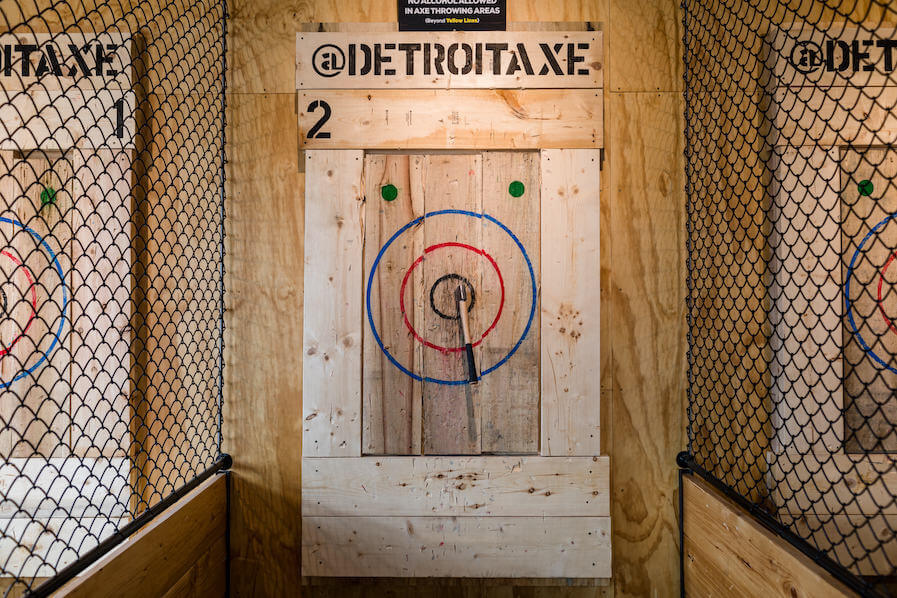Step Up Your Game with Axe Throwing Denver: Master Your Competencies Today
Step Up Your Game with Axe Throwing Denver: Master Your Competencies Today
Blog Article
The Fun of Axe Throwing: Just How This Sport Integrates Skill and Adrenaline for a Good Time
Axe throwing has emerged as a captivating sporting activity that masterfully links the requirement for specific skill with the rush of adrenaline, offering participants a engaging and special experience. The act of tossing an axe in the direction of a target requires concentration and strategy, at the same time promoting an atmosphere of camaraderie and pleasant competition.
The Origins of Axe Throwing
Axe throwing, a recreational task that has actually gained significant popularity in recent years, traces its roots back to ancient times. The earliest documents of axe use in affordable contexts are located among the Celts and Vikings, who threw axes for sporting activity as well as in battle training.
Medieval European warriors, especially throughout the Center Ages, practiced axe throwing as component of their martial training. The Francisca, a sort of throwing axe used by the Franks, came to be iconic for its deadly accuracy. This traditional tool was created to be tossed at opponent guards and armor, showcasing its double utility in both sport and battle.
In more current history, axe throwing saw a resurgence in the logging camps of North America in the 19th and 20th centuries. Lumberjacks would take part in pleasant competition, evaluating their precision and strength by focusing on wood targets. This advancement from a survival ability to a leisure activity has led the way for its modern-day renewal, with specialized places and organizations now celebrating the sporting activity globally.
Devices You Required
Comprehending the rich background of axe tossing improves the gratitude of the sporting activity's contemporary version. Central to this thrilling activity is the tools, which is crucial for both safety and performance. The primary tool is, naturally, the axe. For affordable and leisure axe throwing, one of the most commonly made use of kind is the hatchet, usually weighing in between 1.25 to 2 extra pounds with a manage length of about 16 inches. The axe needs to have a sharp, well-kept blade and a handle made from sturdy wood or composite product, making sure an excellent grip and balance.
Similarly essential is the target. Regulation targets are built from wood, with softwood varieties like pine or cottonwood being preferred for their capability to hold the axe and take in. The target is usually split right into 5 concentric circles, each with a specific factor worth, to assist in scoring.
Safety gear, though commonly neglected, is critical. Protective gloves can enhance hold and avoid sores, while closed-toed shoes are a should to shield feet from gone down axes (axe throwing denver). A well-lit, spacious tossing area, full with security barriers, guarantees a regulated environment where participants can concentrate on developing their abilities.
Standard Techniques Described
Understanding the basic techniques of axe throwing is essential for both safety and security and efficiency. The dominant hand must be positioned directly listed below the axe head, while the non-dominant hand sustains the end of the handle.
Following, concentrate on the position. Stand with your feet shoulder-width apart, ensuring your body is balanced. Your leading foot must be a little forward, straightening with your target. This positioning help in preserving stability and directing power precisely in the direction of the target.

Safety And Security First
Ensuring safety in axe throwing is critical to developing an injury-free and delightful experience. A well-designed axe tossing facility features clear demarcations in between throwing lanes, sturdy backgrounds to capture stray axes, and non-slip floor covering to avoid accidents.
Benefits of Axe Throwing
Axe tossing deals a myriad of benefits that extend beyond straightforward recreation. Physically, it gives a full-body workout, involving muscles in the arms, shoulders, back, and core. The repetitive movement of tossing the axe likewise enhances hand-eye control and great motor skills. For those looking to boost their total health and fitness, axe throwing can work as a interesting and dynamic kind of workout.
Mentally, axe throwing calls for accuracy, emphasis, and strategy, making it a superb way to hone cognitive skills. The focus required to strike the target can work as a type of mindfulness, allowing individuals to remove their minds and decrease stress. This mental engagement can be specifically beneficial in assisting people develop much better problem-solving skills and psychological resilience.
Socially, axe throwing is often appreciated in group setups, promoting team-building and camaraderie. Whether as part of a business occasion or a laid-back outing with buddies, the sporting activity motivates interaction and collaboration. In addition, the public experience of discovering and boosting together can strengthen partnerships and develop enduring memories.
Final Thought

The earliest documents of axe use in link affordable contexts are found among the Celts and Vikings, who threw axes for sporting activity as well as in fight training. Release the axe when your hands are about at eye degree, allowing the axe's natural turning to assist it towards the target.
A well-designed axe throwing center attributes clear demarcations between tossing lanes, tough backgrounds to catch roaming axes, and non-slip flooring to prevent accidents. Participants should be instructed on the right method to toss the axe and deal with, stressing regulated, purposeful activities over strong throws.
In recap, axe tossing stands out as a sport that masterfully incorporates skill, precision, and adrenaline.
Report this page